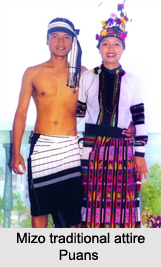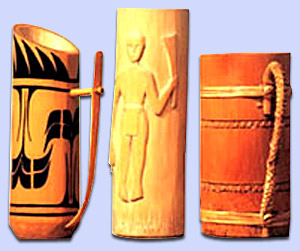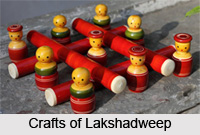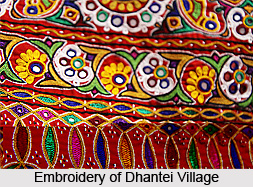 The Mizos are a part of the new Kuki group of tribes settled in Manipur. They term their produced fabrics as "Puan", which are multiple in number but more or less identical in designs amongst almost all the Mizo Kuki tribes, with minor local variations.
The Mizos are a part of the new Kuki group of tribes settled in Manipur. They term their produced fabrics as "Puan", which are multiple in number but more or less identical in designs amongst almost all the Mizo Kuki tribes, with minor local variations.
A Puan is normally about a metre in length and 3 to 4 metres in breadth. In the beginning, the Mizo Kukis did not have any coloured yarns to weave their fabrics, therefore, the cloth produced used to be only a simple thick white piece for both men and women. Another piece of a bigger size was often used by men as a wrapper to cover the upper part of their body, in order to prevent them from cold as also to enable them to use the same for various other purposes such as a sheet to sleep on or to cover their body while sleeping in Zawlbuk (the bachelors" dormitory). In their simple primitive society, such a pair of cloth for man was considered adequate enough to meet the needs of all climatic conditions prevalent in the area they were settled in. These puans used to be conspicuous by the absence of any other colour for quite a long time, and were called "Puanngo". In course of time, they discovered that certain barks, roots, herbs and leaves could yield fast black colour. Naturally thus, came the use of black borders on their tunics, while some of them were entirely made of black surface with their white stripes, thereby bringing desirable variations in their earlier simple white clothes. They kept discovering more colours with time, and thus came the use of red, yellow, green and blue colours on their cloth.
Soon, the artistic talent of the Mizo Kukis encouraged them to develop and promote different designs in their textiles, and the earliest design made was called "Kwakpuirikzial", which is popular even today. "Puanhruih", also known as "Ngotekherh", is a traditional puan highly prized by the Mizos. In the beginning, this puan used to be more popularly known as Puanhruih, appearing to have received its name from the word "Hruih", which means transverse strips on cloth. The weaving of these strips too was specially designed whereby the weft almost completely hid the warp from common view. This puan is also known as Ngotekherh, the term in fact being commonly applicable now. It is derived from the word "Ngote", which is a common pet name for young boys and girls, and "Kherh", which again means transverse strips. This particular puan is woven with a white background with black stripes on it. Two deep borders, about 10 to 12 centimetres broad run along the two edge lengths. Adjoining these borders are the black stripes, woven numbering about two to six as per the individual wearer"s liking. These are so spaced that the intervening white portions look like white stripes of the same breadth. Besides these, quite a few other black stripes of similar breadth are woven throughout the surface length of the cloth between the two broad borders on the edges. But these stripes are spaced differently from the ones adjoining the edge black borders. Usually, the spacing between these stripes is maintained between 10 to 12 centimetres. However, there is no rigidity about this and the spacing is often arranged as per individual taste. In addition to these lengthwise borders and stripes, there are two broad black bars woven with wool, running in the middle of the puan breadth wise, dividing it into three equal portions. The entire weaving of these stripes, borders and bars is characterised by the distinctive feature wherein the white wool is delicately hidden under the black warp. Sometimes, black stripes near the broad black borders along the edges are decorated with simple patterns of weaving, which lead to the appearance of black and white chains of delicate designs. The hidden black stripes between the white surfaces produce a faint checked-like appearance, when the puan is viewed against.
Apart from "Kwakpuirikzial" and "Puanhruih", the varied multiple designs of these Puan fabrics include "Puanndum", "Tawlhloh-Puan", "Kawkpuipar", "Disul", "Puanchei", "Puancheite", "Thembupui-Chung", "Par-zam", "Naya Sawm Par", "Arsi Par", "Sawhthing Par", "Fanghma Mu", "Semit", "Siki Par", "Zawngdaikalh Chhunga Arsi Leh Phengphehlep Seh Thalak", "Herhsawp Leh Kawkpui", "Zawngdaikalh Leh Lace Par" and "Zawngdaikalh Chhunga Lace Par".
Related Articles:
Manipur
Textiles of Manipur
Crafts of Manipur
Tribes of Manipur
Indian Costumes
Weaving and Dyeing Craft
Mizos
Kukis
Woollen Textiles, India






